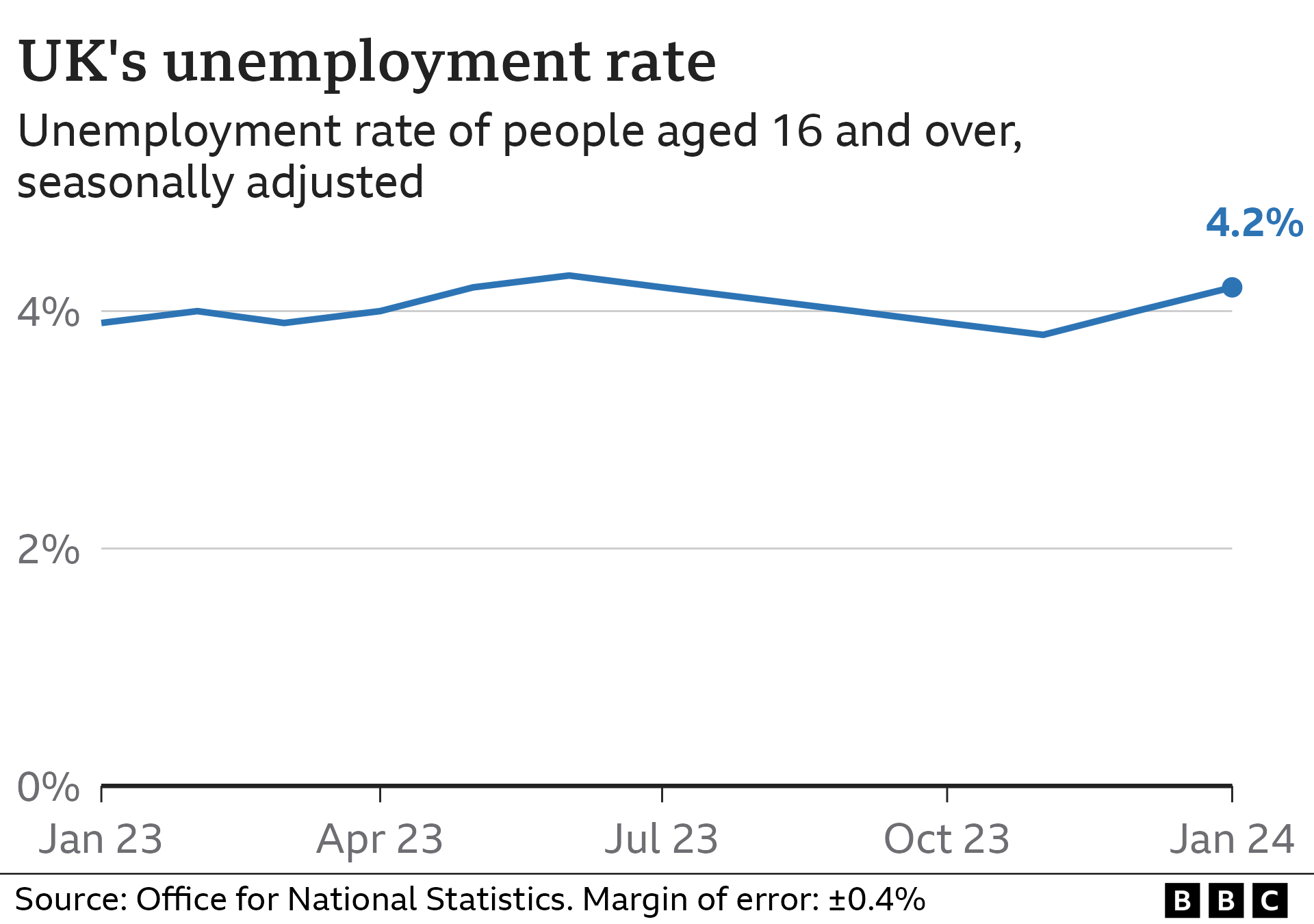Unemployment jumps as UK jobs market stalls
- Published
- comments

The UK jobs market is showing signs of stalling as the number of people out of work rose, according to new figures.
The unemployment rate increased to 4.2% between December and February, which is the highest level for six months.
Meanwhile, the rate of people with a job dipped and the economically inactive - those not in work or looking for employment - ticked higher.
Economists suggested the data could spur the Bank of England to cut interest rates in the summer.
"With employment falling sharply and the unemployment rate climbing, we suspect wage growth will continue to ease in the coming months," said Paul Dales, chief UK economist at Capital Economics.
"That may allow the Bank to cut interest rates in June."
Yael Selfin, chief economist at KPMG UK, added: "Easing pressure in the labour market keeps the Bank on track for a summer rate cut."
The Office for National Statistics (ONS) said there are "tentative signs that the jobs market is beginning to cool".
Overall, the ONS said the UK's unemployment rate rose from 3.9% in the three months to January and surpassed economists' forecast of an increase to 4%.
In total, there were 1.4 million unemployed people in the UK between December and February, it said.

However, other figures showed that while average wage growth, excluding bonuses, edged down from 6.1% to 6% it remained far above forecasts.
And, when taking inflation into account, real wages rose by 1.9% in the three months to February. This was the highest since the three months to September in 2021.
Chancellor Jeremy Hunt praised the growth in real wages and said that with the government's recent cut in National Insurance for the employed and self-employed, which came into force on 6 April, "people should start to feel the difference".
But a freeze in income tax thresholds until 2028 means that as people's wages increase they risk entering a higher bracket and paying more tax.
Pay growth
Wage growth is a key point monitored by the Bank of England when deciding whether or not to cut interest rates because it can fuel inflation - which measures the pace at which prices are rising.
The rate of inflation has been easing. From a record high of 11.1% in October 2022, it slowed to 3.4% in the year to February and new data due out on Wednesday is expected to show a further deceleration for the 12 months to March.
But the Bank of England has a target to keep inflation at 2% and if wages continue to grow there is a risk it could head higher.
"Even though headline inflation is on track to hit its target in the next few months, policymakers are concerned that persistently high pay might cause it to pop back up, and this snapshot does very little to alleviate those fears," said Susannah Streeter, head of money and markets at investment firm Hargreaves Lansdown.
However, Rob Wood, chief UK economist at Pantheon Macroeconomics, said: "Wages lag labour market slack, so these figures will likely embolden the [Bank of England's] monetary policy committee to begin cutting interest rates this summer."
The ONS said employment rate dipped to 74.5% between December and February and the percentage of 16 to 64 year-olds defined as economically inactive rose from 21.8% to 22.2%, which equates to 9.4 million people.
But it warned its figures should be treated with a degree of caution because they were based on a smaller sample of household questionnaires than it used to rely on before the Covid pandemic.
Tony Wilson, director of the Institute for Employment Studies, said that the jobs market data was "very volatile so don't read too much into short-term changes".
"But the trend is clearly poor," he added.
The number of UK vacancies also slowed, dropping by 13,000 between January and March to 916,000, but the number of jobs that need filling remains above pre-Covid levels.
The ONS said the most recent rise in the number of people classed as economically inactive was driven by those aged between 16 and 34 years old. Looking across all age groups, students and those suffering from long-term sickness have fuelled inactivity numbers.
Tracy Evans, 59, from Bridlington in Yorkshire, contracted severe long Covid in January 2021 after 30 years as a care assistant.

Long Covid has forced Tracy Evans to give up a job she loved
She told the BBC she has been unfit for work due to symptoms such as severe fatigue and brain fog. "Any exertion I am breathless. I'm tired just having a shower or getting dressed," she said.
Mrs Evans said that she tried to go back to work last year. "I thought that would be ok because many of the tasks I was given I could be sat down and resting," she said.
However, staffing shortages led her health to deteriorate further and left her "in bed for weeks". As a result Mrs Evans was forced to give up the job she loved.
Labour's Acting Shadow Work and Pensions Secretary, Alison McGovern, said the latest ONS figures revealed "the cost of Tory chaos with a record number of people locked out of work due to long-term sickness at terrible cost to them, to business and to the taxpayer paying billions more a year in spiralling benefit bills".
Liberal Democrat Treasury spokesperson, Sarah Olney, said: "Record levels of people are off work due to long-term sickness, many struggling to access the healthcare they need. It shows this Conservative government's neglect of the NHS is damaging the country's economic recovery."

Six expert tips for finding work
1. Search beyond a 40 mile radius - Remote, hybrid and flexible working open up opportunities further away.
2. Use key words in your searches - Online algorithms will pick up on daily searches and send you more of the same.
3.Don't wait for a job to be advertised - Contact a manager at a business that you like the look of as you never know what opportunities might be coming up.
4. Sell your skills - Use social media sites like Linkedin which showcase your skills and experience. Other platforms like Twitter and Instagram can prove useful when touting yourself out to potential employers as well.
5. Get learning - While you're on the hunt for a job see if there are way to fill gaps in your CV with free courses, volunteering or shadowing.
6. Celebrate the small wins - set personal targets, like a tracker of the number of jobs to apply for in a week or a certain number of cold emails and acknowledge the little wins along the way to keep your spirits up.
You can read tips from careers experts in full here.

Related topics
- Published26 March

- Published15 April 2024
